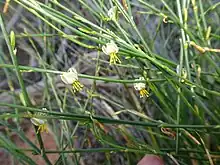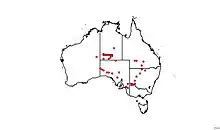Corynotheca licrota
Corynotheca licrota, otherwise known as the antler zig-zag lily,[1] club-fruit lily,[1] or sand lily,[2] is a perennial herbaceous member of the family Asphodelaceae and is found in arid inland areas of Australia.
| Sand lily | |
|---|---|
 | |
| Scientific classification | |
| Kingdom: | Plantae |
| Clade: | Tracheophytes |
| Clade: | Angiosperms |
| Clade: | Monocots |
| Order: | Asparagales |
| Family: | Asphodelaceae |
| Subfamily: | Hemerocallidoideae |
| Genus: | Corynotheca |
| Species: | C. licrota |
| Binomial name | |
| Corynotheca licrota | |
 | |
| Occurrence data from AVH | |
Description
Corynotheca licrota is a tufted shrub that grows up to 700mm and is grass-like in appearance. The leaves are linear in shape and can grow up to 600mm. [2] Stems are much shorter at 5mm long. [3] Inflorescence are widely branched with solitary flowers. Petals are white to cream to pale yellow in colour and sepals are often a darker pink to purple to brown colour. [2][3] The petals are a narrow elliptical shape that are 3.9-5.5mm long and 0.7-0.9mm wide. The pendulous capsules are brown and wrinkly looking and ovoid to obovoid in shape. They are 2.8-7.5mm long and 2.1-2.8mm wide. 1-5 seeds are found in each fruit. They are glossy black to iridescent in colour and have a smooth or slightly corrugated texture. Flowering occurs mostly from September to February but can also occur in April and August after rainfall. [3]
Distribution and habitat
This species is endemic to Australia and occurs mostly in the arid areas of the country. However, it has been found in all states excepting Tasmania. [1] Three fairly distinct populations have been noted in the central ranges, Murray-Darling Basin and southern SA. Distribution has been tracked along drainage paths of the Darling and lower Murray, which suggests seeds may be carried from Central Australia by the rivers. [3] It is common that C. licrota grows on sandy plains or dunes in low rainfall areas, [1] and often in conjunction with mallee scrub or pine-buloke forests. [2] Corynotheca species are key in their habitat because of the dense shelter they provide invertebrates and small vertebrates and their ability to resprout rapidly after fires. [3]
Conservation status
This species is listed as Endangered in Victoria,[2] Rare in South Australia,[4] Near Threatened in the Northern Territory,[5] of Least Concern in Queensland,[6] Not Threatened in Western Australia,[7] and not currently listed in New South Wales[8] and the Australian Capital Territory.[9] It is not listed under the Environment Protection and Biodiversity Conservation Act 1999.[10]
Taxonomy
This species was first formally classified at species rank by Australian botanist Rodney John Francis Henderson in 1987 in the Flora of Australia collection. [11] Prior to this, C. licrota was included under Corynotheca lateriflora and separated at varietal rank by Austrian botanist Erwin Gauba. [3]
Synonyms for Corynotheca licrota include:
- Corynotheca lateriflora var. laevisperma[12]
- Caesia lateriflora[2] as classified by Robert Brown.
Corynotheca licrota and C. lateriflora are similar and easily misidentified.[3]
References
- "Corynotheca licrota". New South Wales Flora Online. PlantNET. Retrieved 24 October 2022.
- "Flora of Victoria". VicFlora. Royal Botanic Gardens Victoria. Retrieved 24 October 2022.
- Barrett, Russell; Macfarlane, Terry, D; Keighery, Gregory, J (2021). "Taxonomic Revision of Corynotheca (Hemerocallidaceae / Asphodelaceae)". Telopea. 24: 7-52. doi:10.7751/telopea14693.
{{cite journal}}: CS1 maint: multiple names: authors list (link) - "National Parks and Wildlife Act 1972" (PDF) (PDF). Department for Environment and Water (South Australia). March 2021. Retrieved 28 October 2022.
- "Northern Territory Flora Online". FloraNT. Northern Territory Government. Retrieved 24 October 2022.
- "Species Profile - Corynotheca licrota (club fruit lily)". Queensland Government. Queensland Government. Retrieved 24 October 2022.
- "Corynotheca licrota". Florabase. Department of Biodiversity, Conservation and Attractions. Retrieved 24 October 2022.
- "Threatened Biodiversity Profile Search". Office of Environment & Heritage. NSW Government. Retrieved 24 October 2022.
- "Threatened Species and Ecological Communities". Environment, Planning and Sustainable Development Directorate - Environment. ACT Government. Retrieved 24 October 2022.
- "EPBC Act List of Threatened Flora". Species Profile and Threats Database. Department of Climate Change, Energy, the Environment and Water. Retrieved 24 October 2022.
- "Henderson, Rodney John Francis". Australian National Herbarium. Australian National Herbarium. Retrieved 24 October 2022.
- George, A.S., ed. (1987). Flora of Australia: Volume 45. Australian Government Publishing Service.